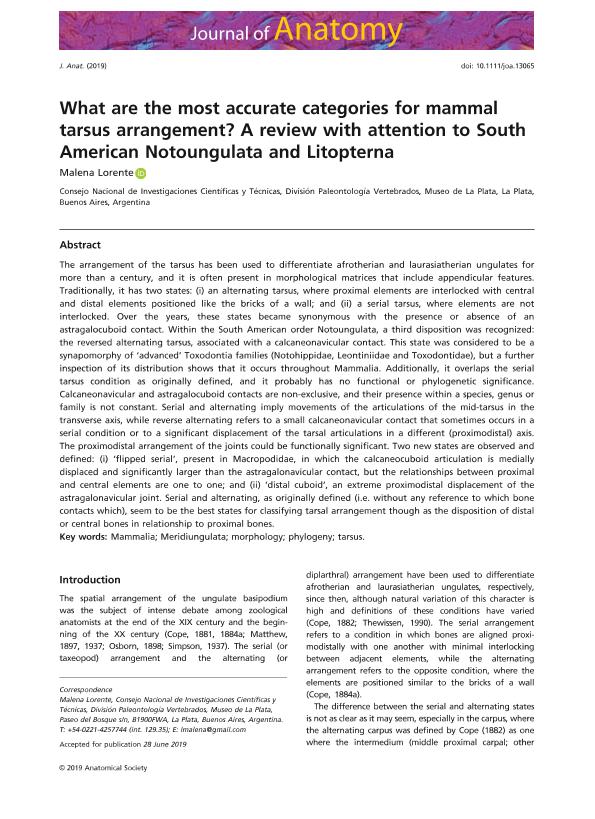Artículo
What are the most accurate categories for mammal tarsus arrangement? A review with attention to South American Notoungulata and Litopterna
Fecha de publicación:
12/2019
Editorial:
Wiley Blackwell Publishing, Inc
Revista:
Journal of Anatomy
ISSN:
0021-8782
Idioma:
Inglés
Tipo de recurso:
Artículo publicado
Clasificación temática:
Resumen
The arrangement of the tarsus has been used to differentiate afrotherian and laurasiatherian ungulates for more than a century, and it is often present in morphological matrices that include appendicular features. Traditionally, it has two states: (i) an alternating tarsus, where proximal elements are interlocked with central and distal elements positioned like the bricks of a wall; and (ii) a serial tarsus, where elements are not interlocked. Over the years, these states became synonymous with the presence or absence of an astragalocuboid contact. Within the South American order Notoungulata, a third disposition was recognized: the reversed alternating tarsus, associated with a calcaneonavicular contact. This state was considered to be a synapomorphy of ‘advanced’ Toxodontia families (Notohippidae, Leontiniidae and Toxodontidae), but a further inspection of its distribution shows that it occurs throughout Mammalia. Additionally, it overlaps the serial tarsus condition as originally defined, and it probably has no functional or phylogenetic significance. Calcaneonavicular and astragalocuboid contacts are non-exclusive, and their presence within a species, genus or family is not constant. Serial and alternating imply movements of the articulations of the mid-tarsus in the transverse axis, while reverse alternating refers to a small calcaneonavicular contact that sometimes occurs in a serial condition or to a significant displacement of the tarsal articulations in a different (proximodistal) axis. The proximodistal arrangement of the joints could be functionally significant. Two new states are observed and defined: (i) ‘flipped serial’, present in Macropodidae, in which the calcaneocuboid articulation is medially displaced and significantly larger than the astragalonavicular contact, but the relationships between proximal and central elements are one to one; and (ii) ‘distal cuboid’, an extreme proximodistal displacement of the astragalonavicular joint. Serial and alternating, as originally defined (i.e. without any reference to which bone contacts which), seem to be the best states for classifying tarsal arrangement though as the disposition of distal or central bones in relationship to proximal bones.
Palabras clave:
MAMMALIA
,
MERIDIUNGULATA
,
MORPHOLOGY
,
PHYLOGENY
,
TARSUS
Archivos asociados
Licencia
Identificadores
Colecciones
Articulos(CCT - LA PLATA)
Articulos de CTRO.CIENTIFICO TECNOL.CONICET - LA PLATA
Articulos de CTRO.CIENTIFICO TECNOL.CONICET - LA PLATA
Citación
Lorente, Malena; What are the most accurate categories for mammal tarsus arrangement? A review with attention to South American Notoungulata and Litopterna; Wiley Blackwell Publishing, Inc; Journal of Anatomy; 235; 6; 12-2019; 1024-1035
Compartir
Altmétricas




